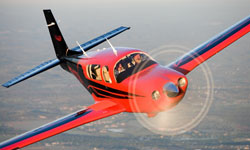GA deliveries broke records in 2007
 By Paul Richfield
By Paul Richfield
Strong worldwide demand for aircraft—business jets and turboprops in particular—pushed general aviation industry billings to a record high of nearly $22 billion in 2007, a 16.5-percent increase over the previous year.
According to the General Aviation Manufacturers Association (GAMA), global shipments of GA aircraft totaled 4,272 units in 2007, compared with 4,053 deliveries in 2006. Business jet shipments reached an all-time high, surpassing 1,000 units for the first time.
Piston airplane deliveries dropped by 2.9 percent in 2007 “but still posted the second best year in over two decades,” GAMA said. Total piston aircraft shipments decreased from 2,755 in 2006 to 2,675 last year. Turboprop deliveries were up 11.4 percent, from 412 units to 459 units, while business jet shipments rose from 886 to 1,138 units—a 28.4-percent increase.
Speaking at GAMA’s annual Industry Review and Market Outlook Briefing in Washington, D.C., on Feb. 12, GAMA Chairman and Cirrus Design CEO Alan Klapmeier said that despite the positive delivery picture, the GA industry still faces significant challenges.
“We need to grow the pilot population and stop the long-term decline in the number of GA pilots,” he said. “We have to grow the low end of the market, and bring inactive pilots back into the fold.”
Klapmeier lauded efforts to meet these goals, including AOPA’s Project Pilot initiative and the EAA Young Eagles program. The Cirrus chief also expressed excitement over the growing light sport aircraft movement, saying the recent entry of two industry heavyweights—Cirrus and Cessna—into the LSA market segment underscores a growing commitment to increasing pilot starts.
The industry-wide shortage of aviation engineers, mechanics, and other technical personnel must also be addressed, according to Klapmeier. “We have to get people focused on engineering education and make them aware that aviation is a viable and rewarding career path,” he said.
GAMA President Pete Bunce echoed those comments, adding that the GA industry must get more involved with the FAA’s “NextGen” air traffic control system modernization plan. He encouraged GA manufacturers to take a more proactive role in adopting two related technologies: required navigation performance (RNP) and automatic dependent surveillance-broadcast (ADS-B).
“We know the general plan, but we need to know the end result,” he said. “We believe that most of the cost [of ATC modernization] is going to go to the aircraft, but we need to see the detailed system performance requirements as soon as possible. As [AOPA President] Phil Boyer says, it isn’t ‘NextGen’ anymore; it’s ‘NowGen.’”
February 13, 2008
